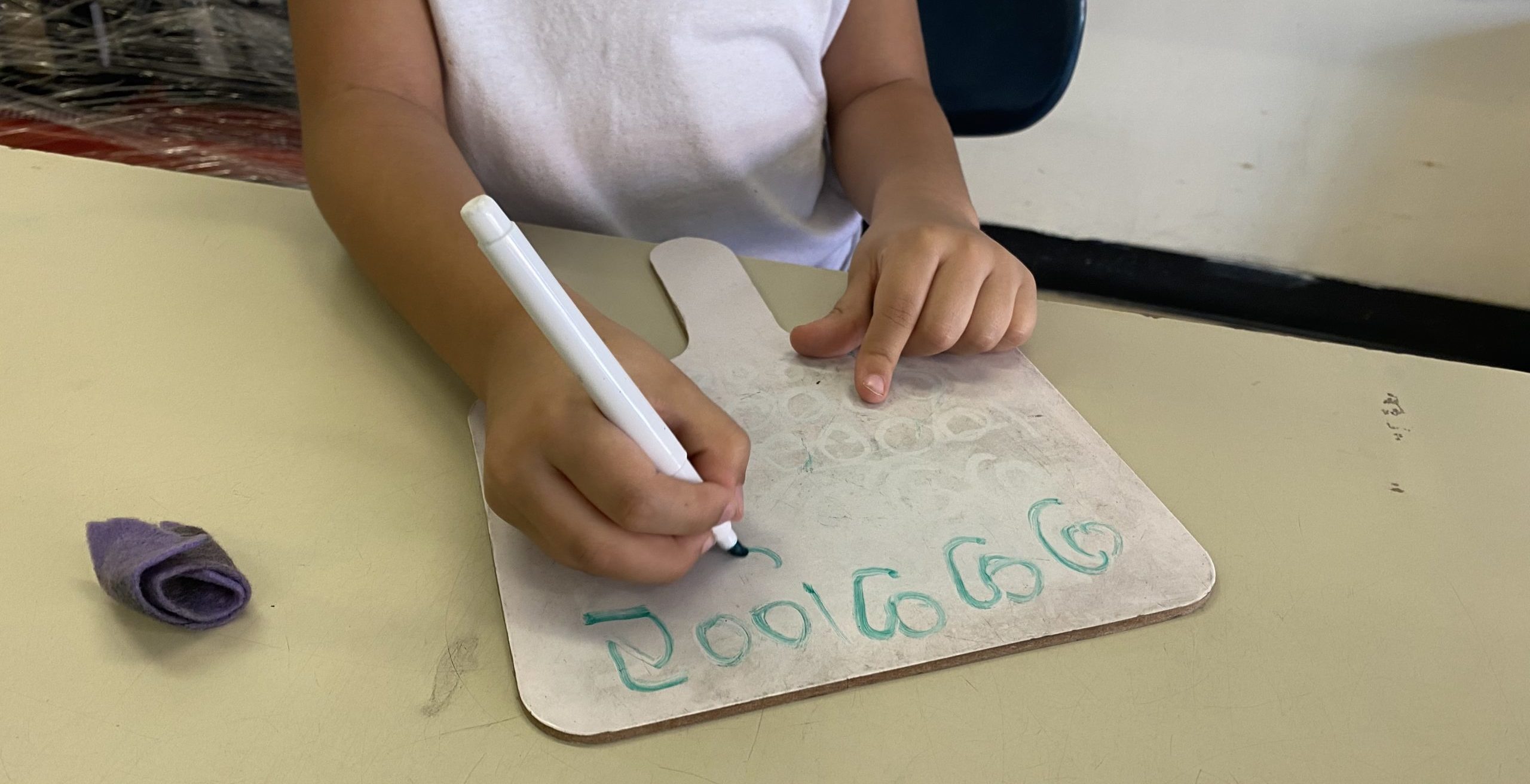Behind The Mask: A Look Inside Our Public Schools
Boston Public Schools students may have returned to the classroom for 2022, but things are far from “normal.” Despite transitioning back from remote learning, students and teachers say this school year may be the toughest yet. What does it really look like inside BPS buildings today? As we approach spring break, some of our staff members look back on what they’ve seen and heard while volunteering in-person this year.
Q: Now that we’re back in classrooms, what are your initial impressions of this school year? What’s it like inside the school walls?
Erin McGrath: Out of my twenty years mentoring students in the Boston Public Schools, this year has been the wildest one I’ve experienced – and yes, that includes last year. I’ve read many articles and I’ve heard a lot of folks lamenting the failures of remote learning; it certainly did have its challenges. But once we collectively figured out the technology, it also provided two important things: predictability and consistency. This year, situations shift more frequently than I have seen before, meaning that anyone working in schools needs to possess flexibility and patience in order to manage.
I’m back at the school I’ve been serving at since 2010, working with a group of first-grade students. Some of the changes here are expected and predictable: multiple signs advising folks entering the building to wear masks, hand sanitizer and extra masks everywhere, and stickers on the floor to help everyone remember to practice social distancing. Walking through the halls each week to get to the classroom, it feels like everyone is a little tense. They’re still friendly and welcoming, greeting me with a “good morning” and a smile under their masks, but more so than in previous years, folks are in a hurry. There are fewer people moving about the building in general, no doubt a product of the reduction in visitors – only partners who work directly with students are allowed to be present.
Fenway High School Student: This year is way more challenging than last year. Last year was all online, and we just knew what was going on. This year, we have no idea if things are gonna change. COVID is always on my mind. You never know if someone has it – it’s just harder to learn.
Andy Kall: The main difference I’ve seen, aside from students being masked and spread out a little bit more, is getting adjusted to learning while there’s that day-to-day worry of “am I going to get COVID?” I’m working with a group of 11th graders, and they know what’s going on – they’re not naive to what’s happening in the world. I was waiting for a lesson to start a few weeks ago, and one group of students was talking about when they were going to be eligible for booster shots. That’s what they were talking about, on a Tuesday morning before math class. And I’m looking back on my own high school experience, thinking ‘I would never have thought about that – that’s not anything that would have crossed my mind.’ But it is something that they have to think about. There’s a sense within the classroom that, “yes, I need to be learning, but I also need to be safe. And how do you balance the two of those?” And I think there’s just a different kind of air in the room.
Fenway High School Teacher: Last year, we just got into a groove, you knew what was going on. Everyone was at home all just learning online. This year with school being in person and then so many disruptions with all of the COVID outbreaks, it’s just been a lot different.
Oakley Arave: Assignments feel much more self-focused. I remember when I was in elementary school, and even when I was working in pre-K, we did a lot of center activities where you’re rotating from table to table. And I really don’t see that this year. I see a lot of students will still work on art projects, we still do things like that, but it’s much more independent. All students have their own belongings – they don’t really share too much – and will pull from the class supply of materials to replenish their pencil boxes. They’re still interacting, but they’re not collaborating on schoolwork.
Q: What are some of the main challenges you’re seeing or experiencing?
Fenway High School Student: Because everything was remote last year, there was definitely a gap in what we learned remotely. And then we were just, like, expected to come back and have this base knowledge this year. And it just wasn’t there.
Erin McGrath: Students always need to get used to a new adult presence, and this year it’s taken a bit longer because there are so many factors disrupting our rhythm. The first few weeks, the biggest challenge was the COVID pool testing – students whose parents granted permission get pulled out of class to test them for COVID – a very good thing! The challenge is that there’s no way of knowing the schedule in advance; students need to go whenever the tester comes for them. This makes it hard for teachers to keep a rhythm and flow to their lessons, and sometimes means just sitting down with one of my students only to have them whisked away.
As the months have gone on, the primary challenge has become the absences of both staff and students due to the spread of Omicron. At times in December we’d be down to only 6 or 7 students and pinch-hitting substitutes. The swim teacher had to take on the class one day (and did a great job!) and in other schools, administrative staff from the Central Office covered everything from classrooms to the school secretary role.
Andy Kall: There definitely have been days where the absences in the classroom have been noticeable. So it’s lighter classes. I think the first time I came back after the holiday break, probably half the class was there. Both of my teachers have been very fortunate, but just talking with other teachers and educators, they definitely feel the absences more. I think that first day back from break, there were about 1,000 teachers that called in sick across BPS and that’s something real that they have to face right now.
Erin McGrath: Another understated difficulty here is that for children, and especially in first grade, repetition is vital to building the skills we’re working on. Repeating instructions in the same way each day, having a reliable schedule and a predictable routine, are critical to successful literacy and numeracy in early childhood. In addition, because the students in this classroom didn’t get to attend kindergarten in person, they’ve missed out on a formative experience in just learning how to be in school. Kindergarten provides socialization and training on how school works, and the remote environment last year couldn’t replicate those benefits.

Q: What about the triumphs?
Erin McGrath: Despite all of the challenges that illness, inconsistency, and disruption bring, I’m constantly struck by how well everyone in the school is making it work. The students are happy to be in the classroom, learning with their friends. The teachers roll with interruptions and last-minute changes with consummate grace. And when folks were out sick, the community stepped up to make sure that children kept learning.
I’ve been privileged to see the students I’m working with really thrive and make progress in the areas we’re working on together. My classroom teacher prepared me beautifully. I have a folder in the classroom with activities and learning goals for each of my students. That means that regardless of whether there’s a substitute or a change of classroom plans for the day, I always know what I need to do and how I can help. One of my students is working on his letter formation skills, and the improvement he’s made since November is dramatic, in part because he has this extra, focused time to practice.
Andy Kall: I’m in an inclusion classroom this year, so in addition to the head teacher, we also have an anotherl teacher in the room. And then there are two student teachers. So, including mentors, there are typically six adults in the classroom on Tuesday mornings this year. What I’ve seen is actually something that we talk about all the time – that this extra support is so valuable. When we break into small groups this year, we’re able to have an adult at every single table. Every single table, including mine, has an adult sitting there and working with the students. And I think that makes a big difference when the students are working on these challenging math problems.
Also, sometimes our classes now end with a reflection period among the whole class. You reflect on something that you were either grateful for, or that you were encouraged by during that class period. And all the students go around and thank each other for helping each other and things like that. And it’s really cool. I haven’t really been a part of something like that in a high school setting before. And I thought it was really encouraging for me, as an outside volunteer, that I was included in that as well. They included me. I’ve always felt very included in the classroom. It’s fun to be a part of that.
Oakley Arave: The funny thing is, since I work with first graders, they actually know very little about pre-pandemic life. So while they act very similar to how first graders acted pre-pandemic – always trying to test their boundaries or goof around – the first graders I work with adapted to COVID expectations very quickly because they don’t know any different when it comes to class procedures. They’re very well adapted to the new rules – they already understand to stay six feet apart, they know how to follow certain sanitation protocols put in place by the schools, things like that. It really did amaze me how well adapted they were to mid-pandemic life.
Q: Anything else you’re seeing and hearing inside the classroom this year?
Andy Kall: I can feel the importance, you can see the importance of in-person, especially after so many disruptions over the last couple of years. You can physically see the separation that students have from each other. And as an adult, being able to sit there in between and work with them and focus and provide guidance – you can see the benefits of it happening in front of your eyes. And I think that’s something really important.
